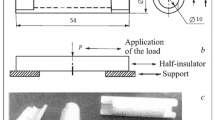Conclusions
In producing corundum refractories from commercial alumina, the technological parameters of the process can be altered widely with respect to their action on the properties of the goods. The basic parameters are firing temperature, grain-size composition, and the quantity of corundum chamotte, the method of preparing the commercial alumina used as the bond, the incorporation of TiO2 as additive, and the firing temperature of the goods.
By changing the technological parameters it is possible to manufacture products with different porosities and strength values, and also with a high resistance to creep under load at high temperatures.
It is also necessary to set up a production cycle for corundum refractories in which it is possible to alter widely the technological parameters required for manufacturing goods with basic properties, providing real variety in their service conditions.
A technology was developed for producing corundum refractories the creep resistance of which at high temperatures and loads make them promising materials for use in high-temperature gas and air heater units of blast furnaces.
Similar content being viewed by others
Literature cited
D. N. Poluboyarinov and V. L. Balkevich, Ogneupory, No. 12, 538 (1949).
D. N. Poluboyarinov and V. L. Balkevich, Ogneupory, No. 3, 109 (1951).
V. A. Bron, Ogneupory, No. 6, 247 (1953).
D. S. Rutman, Ogneupory, No. 4, 237 (1954).
V. A. Bron, Bull. Tech. Info. VIO, Metallurgizdat, No. 5, 46 (1958).
I. S. Kainarskii et al., Ogneupory, No. 2, 37 (1965).
V. G. Lemeshev and V. L. Balkevich, Trudy D. I. Mendeleev,MKhTI, LV, 124 (1967).
V. A. Bron, Ogneupory, No. 7, 312 (1951).
G. V. Kukolev and E. N. Leve, ZhPKh,28, No. 9, 911 (1955).
D. N. Poluboyarinov and N. N. Silina, Trudy D. I. Mendeleev, MKhTI,24, 155 (1957).
D. N. Poluboyarinov et al., High-Alumina Ceramic and Refractory Materials [in Russian], Gosstroiizdat (1960).
N. M. Pavlushkin, Sintered Corundum [in Russian], Gosstroiizdat (1961).
É. V. Degtyareva et al., Ogneupory, No. 9, 400 (1964).
I. S. Kainarskii et al., Ogneupory, No. 5, 46 (1966).
I. S. Kainarskii et al., Ogneupory, No. 6, 50 (1966).
I. S. Kainarskii, Dinas [in Russian], Metallurgizdat (1961).
É. V. Degtyareva, Chemistry of High-Temperature Materials [in Russian], Nauka, Leningrad (1967), p. 172.
G. N. Volosevich and D. N. Poluboyarinov, DAN SSSR,113, No. 1, 152 (1957).
H. Cohoow and C. Christensen, J. Amer. Ceram. Soc.,39, No. 10, 337 (1956).
I. E. Dudavskii and S. D. Iosel'zon, Ogneupory, No. 9, 387 (1953).
É. V. Degtyareva and I. S. Kainarskii, DAN,154, No. 4, 937 (1964).
É. V. Degtyareva, Experiments in Technical Mineralogy and Petrography [in Russian], Nauka (1966), p. 212.
I. G. Orlova, Trudy UNIIO, Metallurgizdat, No. 7 (LIV), 77 (1963).
Author information
Authors and Affiliations
Additional information
Translated from Ogneupory, No.2, pp. 46–54, February, 1970.
Rights and permissions
About this article
Cite this article
Kainarskii, I.S., Degtyareva, É.V. & Kabakova, I.I. Effect of some technological parameters on the properties of corundum refractories. Refractories 11, 115–123 (1970). https://doi.org/10.1007/BF01296204
Issue Date:
DOI: https://doi.org/10.1007/BF01296204



